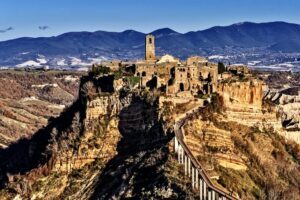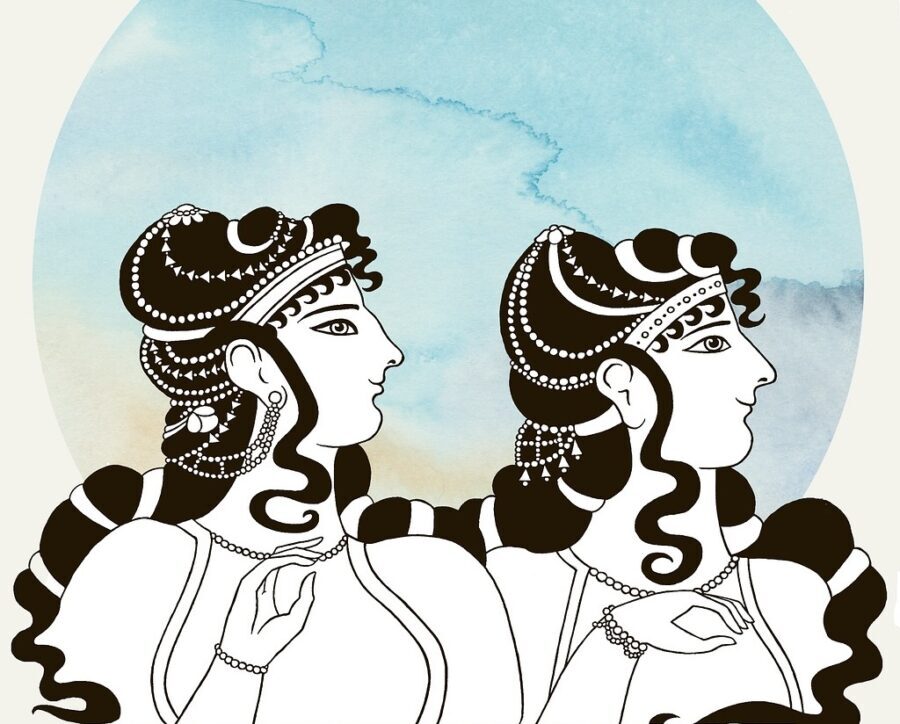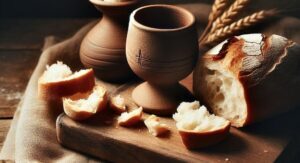
Here with A Loaf of Bread beneath the bough
A flask of Wine, a Book of Verse – and Thou
Beside me singing in the Wilderness
And Wilderness is Paradise enow.
—OMAR KHAYYAM
In the minds of people who have been there, many things are readily associated with Rome: churches and cafes, pines and cypresses, courtyards and piazzas, fountains and ruins. The image most often associated with Roman cuisine, however, is that of bread and wine. In the Eternal City, not a table is set without both.
Both elements have, since antiquity, carried an almost spiritual connotation for the Romans and their fellow Italians. Since bread is made from many grains and wine from countless clusters of grapes, each stands for unity. In the churches of Rome, the sacramental bread and wine become emblems of brotherhood and love. During this Jubilee Year of A.D. 2025, pilgrims by the millions will approach the altar rails of Rome’s Catholic churches to receive the bread and wine of communion which Roman Catholics believe to have been consecrated into the body and blood of Christ.
Some Romans even see bread and wine sharing a natural nine-month cycle and kinship with man and woman. It takes nine months from the time the grain is sown in November until it is reaped and threshed in July to be ground into flour and made into bread. Before wine can be made, the grapes must be allowed to ripen from March to November. And, of course, the miracle of human birth also requires a period of nine months.
In very early Roman times, bread was produced at home through a laborious task of grinding grains of wheat into flour with a mortar and pestle. By the late Republic, the mola versatilis (rotary mill) had been invented, spawning the growth of commercial bakeries. In 1862, excavators unearthed the baking establishment of a man named Modestus, featuring large brick ovens, along with sturdy stone mills for grinding the wheat, and various tools for the making of bread.
This archeological work in Pompeii also yielded loaves of bread, intact but carbonized, giving us an idea of size, shape, weight, and other factors. The typical loaf was round, about twelve inches in diameter, five inches in thickness and one pound, or so, in weight. Curiously, there was a hole in the center, somewhat like our modern coffee cake, and cut into eight pie-wedge-shaped mini-breads.
Panis, bread, quickly became the Roman dietary staple, comprising sixty percent, or more of a person’s main meal of the day (prandium) and a good measure of the breakfast (jentaculum) and evening’s light meal (cena). A typical vignette at a worksite back then – and to this day – remains a group of laborers on a break, each feasting on a thick chunk of bread, washed down with a flask of vinum. (Today these workers are often spotted wearing makeshift hats, made from brown paper bags, to ward off the blazing sun.)
There were several varieties of bread turned out by the city’s myriad bakeries. Panis testutis was a pot bread baked in the oven, while panis artopicius was a pan bread, cooked on top of a stove. There was seeded bread, sponge bread, whole grain, and cake bread. The prevalent variety was the lightly salted panis quadratus, as found in the Pompeii and Herculaneum digs. In his magnum opus, Historia Naturalis, Pliny the Elder discusses bread and bread-making at length, and has lofty praise for the product as being excellent for one’s physical well-being.
The journalist Stacy Nick writes, in one magazine article, of an archeology professor—Emily Wilson at Colorado State University—who seeks to show her classes just how much like us were the ancient Romans. One student was so taken by the Prof’s lecture on the bread of old Rome that she, Kayla Spahr, went back to her dorm and baked a loaf of panis quadratus, guided by Pliny’s words and by pictures of the loaves discovered in Pompeii. Wilson contended that the ordinary Roman men of that long ago era who made up the labor force for building the elaborate public monuments, used bread as the main item of their daily diet. She liked to say: “Bread was the substance that built Eternal Rome.”
______________________________
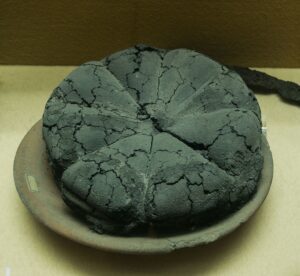
Ancient roman bread, year 76 or 79 CE, from Pompeii, Italy. Jebulon, CC0 1.0 Universal, Wikimedia Commons
______________________________
Bread prices were very reasonable and well within the budgets of even families of meager means. The very poor received subsidized or free grain from the city’s welfare program known as the Cura Annonae (named for Annona the goddess of the grain supply). The satirist Juvenal (A.D. 55-130) mocked the government’s domestic policy as one of “Panem et Circenses,” free bread and free spectacles, as a way of keeping the restless rabble in check by ensuring that their stomachs were always full and their minds distracted. Pliny the Younger lobbied for free books instead of free shows in the arenas.: “Ut panis ventrem sic pascit, lectio mentem,” he would argue: “Just as bread nourishes the body, reading feeds the mind.”
The poet Horace was more mundane on the subject: “Cum sale panis latrantem stomachum bene leniet,” i.e. Bread with salt is enough to calm the stomach that growls.
From the Latin word panis, we English-speaking peoples derive our terms “pantry”, where bread is stored, and “companion,” someone you break bread with.
When setting the table for an elegant dinner party the host would want to be sure that wholesome and delicious bread was included. Bakers could be hired out for such soirees. (Loaves of bread would make for nice gifts to the dinner guests when leaving.) There remains in Rome a street called Via Panisperna. This derives from a tradition in the Middle Ages where an order of the Friars of San Lorenzo daily toiled in distributing to the poor, panis et perna, bread and prosciutto.
Bakers were held in high esteem by the general populace for providing the “staff of life.” They were, at times, the subject of paintings and mosaics. There is a remarkably preserved mural in Pompeii showing a baker behind the counter in his shop, that is stocked with countless wheel-shaped loaves, selling his product to eager customers. Near the central arch of the Porta Maggiore is the elaborate tomb of Eurysaces and his wife Atistia, proprietors of a bread making establishment of the first century B.C. The tomb was discovered during an urban renewal project in 1838. The frieze carvings represent the various phases of producing bread. One relief shows slaves, in tunics, being supervised in their work by the toga-clad owner. Another shows a scale for measuring the weight of the grain, another a sieve for the flour, and yet one more showing the placing of the dough in the oven.
_____________________________
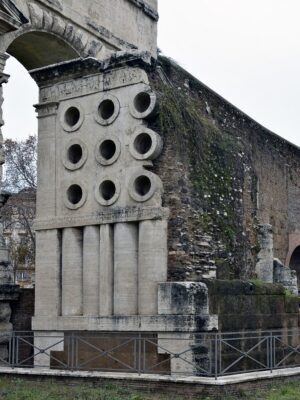
Above and below: tomb of Eurysaces the Baker. Livioandronico2013, CC BY-SA 4.0, Wikimedia Commons
_____________________________
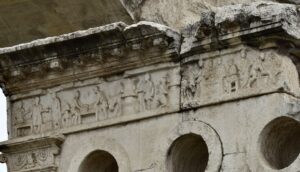
Frieze detail
_____________________________
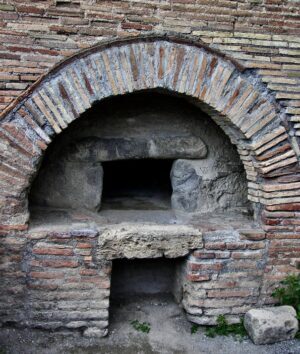
Bakery oven excavated in Pompeii. Wknight94, CC BY-SA 3.0, Wikimedia Commons
_____________________________
…….
As for wine? Pliny covers the subject extensively in Book XIV of his encyclopedia. So too does the contemporary author Luigi Devoti, provide us with information. It existed in Italy long before Rome was founded. Archeological evidence clearly shows that the Etruscans were producing and drinking wine throughout the regions of Tuscany and Lazio as far back as the tenth century before Christ. The ancients believed wine to be of divine origin, a gift to mortals from some deity: Fufluns for the Etruscans, Osiris for the Egyptians, Dionysius for the Greeks, Bacchus for the Romans.
Marcus Porcius Cato, in his book De Agri Cultura, tells us that the planting of the vine was introduced into the city of Rome by its second king, Numa Pompilius (714-671 B.C.). This seems to be corroborated by the existence of wine jugs dating back to that time that have been discovered in very ancient tombs in the Roman countryside. Up to that time, the Romans had access only to imported wines. At first local winemaking was scarce but, by the third century B.C., Roman vineyards were to be found not in the city itself but in the surrounding hill country. The wine called Albanum came from the various communities of the Alban Hills, e.g. towns we know today as Albano, Castelgandolfo, Frascati, Nemi Grottaferrata, Marino, Rocca di Papa, and Velletri, and from slightly more distant areas like Formiae, Sabina, and the regions of Campania and southern Lazio.
Romulus, the first king of Rome (753-714 B.C.), and his subjects used to invoke the blessings of their gods with incense. With the spread of viniculture in later centuries the deities were worshipped, Pliny the Elder says, with the sacrifice of lambs and pigs, along with the smoke of incense and aspersions of wine.
…….
Wines were distinguished according to their taste: sweet (vinum dulce), smooth (vinum suave), weak (vinum fugiens), full-bodied (vinum solidum), bitter (vinum acutum), and so on. Wine came in various colors: white (album), blond (fulvum), blood-red (sanguineum), dark red (rubrum), purple (purpureum).
By the last Republic and early Empire – first century B.C. and A.D. – wine had become the lifeblood of Roman social and domestic life. From writings of that epoch we learn that Cicero loved a wine called Falernum, a dry red from Campania. One host of frequent dinner parties, given to exaggerating the age of his wines to impress distinguished guests, told Cicero that the Falernum being served that particular evening was very aged: “Bibe hoc vinum quadraginta annorum!” (Drink this wine, aged for forty years.) After one sip, Cicero wryly commented, Bene aetatem fert. (It carries its age well.)
Vergil favored Vinum Rhaeticum, a light wine from the region around his birthplace of Mantua; Horace enjoyed Vinum Calenianum, a ruby red from the vineyards near Tibur (modern Tivoli). The poet/satirist often invited his patron Maecenas to dine at his villa out in that hilltown. On one occasion he excitedly sent this invitation to the gentleman:
“Tibi non ante lene merum cade iam dudum apud me est.
Eripe te morae!”
An amphora of excellent untapped wine awaits you here at my place.
Try to break away and come over soon!
Vinum Caecubanum came from a small marshy territory on the coast of Latium (Lazio), overlooking the Tyrrhenian Sea. Elder Pliny hailed it as “noble and wonderful.”
Pliny also points out that Vinum Setinum from the Alban Hills was the preference of the Emperor Augustus:
“Divus Augustus Setinum praetulit cunctis.”
(Augustus used to say that this vintage should be reserved for the table of Bacchus himself.) This was a dry, white wine, light bodied and refreshingly fruity, much like the immensely popular Frascati, found on virtually every restaurant table in Rome these days. As Pliny used to say: “Those hills are clothed with vineyards, whose grapes provide a juice lauded throughout the world.” (From this comment we can plausibly infer that, by then, Roman vintners were heavy into the export business.)
There is in Pompeii a tavern mural showing two men, one with a jug, the other holding a cup. The caption reads, “Adde calicem Setinum’. Another cup of Setinum, please.
In the very early times of King Numa, only the men were allowed to indulge in the fermented grape, because there was a widespread superstition that its consumption could render women infertile or cause an abortion. This rule was ultimately lifted and soon after even the children were being permitted to have a watered-down version of the alcoholic beverage. The alcoholic content of the local wines, incidentally, generally came to about thirteen to fifteen percent. As a result, some adult males were known to prefer mixing with aqua, so as to avoid intoxication. The playwright Apuleius cautioned thus:
(Prima creterra ad situm pertinet, secunda ad hilaritatem, tertia ad
voluptatem, quarta ad insaniam!” The first glass has to do with thirst,
the second with fun, the third with pleasure, the fourth with madness!
Everyone is familiar with Pliny’s observation…”In vino veritas” – in wine there is Truth. But few know the second part of that gentleman’s statement … “In aqua Sanitas”… in water there is Health. A proverb in that era stated:
“Intemperantia medicorum nutrix” – Lack of restraint keeps doctors wealthy. (Yet, some physicians were of the opinion that a robust red wine was good for the blood.) The poet Ovid scoffed at the intemperance warning. He insisted: “Cura fugit multo diluturque mero.” (Good wine drinking diminishes cares and woe.)
At first, the Romans’ consumption of wine was confined to the privacy of one’s home, where even the slaves of affluent families were given a daily ration of a pint or so, especially those assigned to extremely laborious tasks. The military, too, had a similar arrangement with each soldier being issued a daily allotment of one liter. On days of maneuvers, of marches, and of combat, the wine given to the men was in a much watered-down form.
But in due time, wine began to be sold in public places. The most common of these were the cauponae, or inns, often located along the main highways. Later on, taverns started sprouting in the city itself. The Romans knew such a place as vinarius, for drinking at the bar or for take-outs. Rome was in love … with vinum. That wine was plentiful and popular was attested to by the discovery of large terracotta (i.e. clay) jug-eared amphorae each of which held about 26 liters which would be approximately seven gallons. A full amphora weighed around a hundred and ten pounds. There is, just off the Forum in excavated Pompeii, an emporium stacked with such containers, clearly visible to the passerby.
___________________________
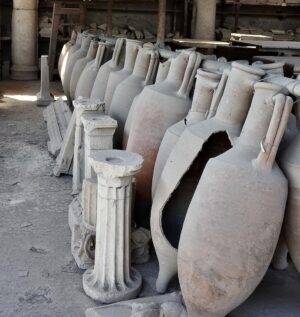
Amphorae, Pompeii. Rob Mitchell, CC0 1.0 Universal, Wikimedia Commons
___________________________
In time, the Roman wine-dealers adopted the oaken barrel which they learned about from the Gauls and which proved to be better for aging the wine and easier to transport (since they were rollable).
Lest we feel that wine always came in only such large vessels, it should be pointed out that in private homes it was stored in much smaller and lighter earthen jugs and sometimes in glass bottles holding about a liter and a half.
The wine industry continued to flourish. By the first century of the Christian era, Rome was awash in wines both domestic, and imported from such far off lands as Gaul, Spain, Greece, Illyria, Egypt, and Asia Minor (modern Turkey). In that very century the prominent Roman writer Marcus Terentius Varro turned out a work of twelve volumes on agriculture (De Re Rustica). He devoted much of one volume to promoting viticulture, encouraging his readers to buy farmland to turn into vineyards. He advised that “no ground, even the most unfavorable, will fail to yield a return far exceeding the initial investment.” Pliny the Younger remembered these words and in his retirement, after a distinguished career in government and in writing, invested in extensive property in the region of Etruria, (most of which is now Tuscany). Sure enough his vineyards yielded a great annual harvest which in turn produced an abundance of wine of good quality. His sprawling country terrain ultimately paid for itself hundreds of times over his original expenses. A leading vintner, Pliny shyly admitted that more people were buying his wine than reading his books, essays, and letter collections. His aim was to bring down the average price of wine. “The poor,” he insisted, “deserve it as much as the rich.” In this, he largely succeeded.
____________________________

Wine storage vessels excavated in situ within the massive Villa Augustea, Dionysiac Villa, located near Somma Vesuviana, a town on the north side of Vesuvius.
____________________________
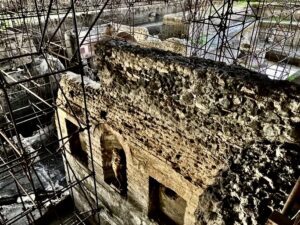
The “Villa of Augustus”, or the Dionysiac Villa, was known as much as a production facility for wine as it was a grand villa.
____________________________
From these ancient beginnings, bread and wine have remained the staples of the Italian diet across the ages. In Rome and all through the boot-shaped peninsula, wine has never been a guarded beverage to be found only in the homes of the affluent. A blue-collar family picnic under a cool umbrella pine out on the Appian Way is certain to include a straw-encased flask of dry wine, rosso or bianco, as well as a wheel-sized loaf of pane. A decanter of wine is ever present on the table of the shepherd, the farmer, the carpenter, the merchant, the teacher, the priest, the nun.
And yet Rome does not seem to have a significant alcoholism problem, for having been given a watered-down taste of wine from childhood on, the vast majority of Romans know how to enjoy it in moderation. From time immemorial, Latin and Italian poets have sung the praises both of bread and wine. One writer says that bread is like a mother, in that we fail to fully appreciate it until we no longer have it. An old proverb insists that a lunch or dinner without wine is like a day without sunshine: “Una cena senza vino e come una giornata senza il sole.” Another puts it like this: “Sine pane et vino Amor esurit.” – Without bread and wine, Love goes hungry, The Italian toast: “Alla salute!” alludes to the health benefits of a drink or two.
Perhaps it is no mere coincidence that the most acclaimed novel to come out of Italy in the twentieth century, a poignant tale by Ignazio Silone, bears the title, PANE E VINO.
_____________________________
*Note: Some archeologists theorize that the first Roman vineyards were cultivated by Greek settlers in the sixth century B.C., on the fertile slopes of Mount Vesuvius, overlooking the Bay of Naples and its surrounding enchantments: Cape Miseno, the Cliffs of Sorrento and the romantic isles of Procida, Ischia, and Capri. An age-old legend tells us that it was Christ himself who got viniculture started there. Neapolitans have long described their breathtaking setting as “Un pezzo del Paradiso caduto sulla terra.” (A piece of Heaven fallen on Earth.) The legend claims that the Lord came down to see it for himself and climbed the slopes of the volcano for a better look. When Christ looked out over this scenic wonder, he wept, and where his tears fell, grapes grew, and from them came the wine that has been called, for centuries untold, Lacrima Christi, Latin for the “Tears of Christ.” This splendid wine was referenced in literature as far back as the 1500’s, in Marlowe’s work “Tamburlaine,” in Votaire’s “Candide”, in Dumas’ “The Count of Monte Cristo.” Romans have across the ages ordered bottles of it to mark special occasions.
Cover Image, Top Left: VesaL, Pixabay


